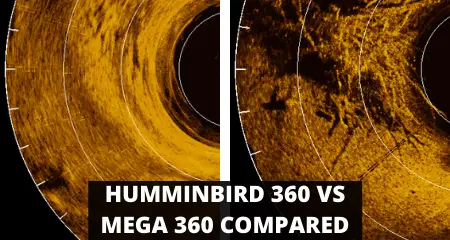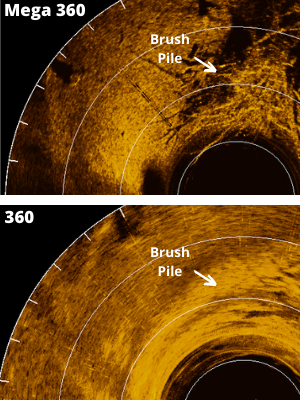Humminbird 360 Vs Mega 360 – What Are The Differences?
UPDATED 17 MAY 2023
by Robert Ceran
Are you wondering what the differences are between Humminbird 360 and Mega 360 imaging, and which one is right for you?
In this article we’ll explain what makes Mega 360 and non Mega 360 transducers different from each other, as well as the image quality they each produce.
We’ll also cover compatibility differences between Mega 360 and non Mega 360 models, to help you decide which one is right for your purposes.

What is the difference between Mega 360 and 360?
While the original Humminbird 360 transducer (released in early 2012) uses non Mega CHIRP with a wavelength of 455 kHz, the Humminbird Mega 360 transducer (released in late 2018) uses Mega CHIRP with a wavelength of 1200 kHz, which generates much higher image resolution.
Another difference between the two Humminbird 360 transducers is that the original non Mega 360 connects to compatible Humminbird units with an ethernet cable, while the Mega 360 connects to compatible devices via a standard transducer cable (similar to other Humminbird transducers).
Due to this difference in connectivity, the two Humminbird 360 transducers are compatible with different, non-overlapping generations of Humminbird head units.
In other words, depending on which Humminbird fish finder you currently have, you can use either non Mega 360 or Mega 360 with it, but not both.
Also, it’s important to note that Humminbird has discontinued the original non Mega 360 transducer (plus most of the head units compatible with it).
So the only way to get your hands on the old version is by buying it second hand, or from legacy stocks available at some retailers.
If you’re currrently debating whether to get 360 imaging or LiveScope, check out our article on Humminbird 360 vs Garmin LiveScope.
Differences in image quality produced by Humminbird 360 vs Mega 360 transducers
Humminbird Mega 360 transducers use megahertz imaging to generate images with very high resolution, showing underwater objects with crisp detail, and allowing you to see very small details such as branches on laydowns, bluegill beds, or individual fish in high resolution.
In contrast to this, the Humminbird 360 non Mega transducer generates images with much lower resolution, showing most objects as blobs with blurry edges that tend to merge into each other.
For an example of this, check out the the photo below, which shows the same brush pile imaged with either 360 or Mega 360 transducers:

The reason for this difference in resolution and image quality is due to the Humminbird 360 non Mega transducer using low frequency CHIRP centered around 455 kHz, while the Mega 360 transducer uses high frequency CHIRP in the megahertz range, centered around 1200 kHz.
The higher megahertz frequency of the Mega 360 not only generates more fine grained object resolution, but also works much better in shallow water than the lower frequency CHIRP of the non mega 360.
And since Humminbird 360 imaging is almost exclusively used in shallow water under 100 feet, this gives the Mega 360 a clear edge in image quality.
For most anglers, the difference in image quality is like night and day, and once they have experienced Mega 360 imaging, they don’t want to go back to the non Mega 360 imaging.
If you’re not sure whether this kind of imaging is right for you, take a look at our article: is Humminbird 360 imaging worth it?
Connectivity differences between Humminbird 360 vs Mega 360 transducers
The original Humminbird 360 transducer was designed to use an ethernet connection to hook up with an ethernet ready head unit of the 700, 800, 900 or 1000 series of Humminbird fish finders.
The Mega 360 transducer, on the other hand, comes with a transducer cable similar to other Humminbird transducers, such as 2D, SI, or DI transducers, designed to connect with compatible Helix, Solix and Apex fish finder units.
These differences in connectivity raise some compatibility issues with respect to the head units that can be used with the two different 360 imaging transducers, which we’ll cover below.
Compatibility differences between Mega 360 and non Mega 360 transducers
Due to their different ways of connecting with head units, each of the Humminbird 360 transducers is compatible with different generations of Humminbird fish finders, which can be summarized as follows:
Humminbird 360 non Mega compatibility
Humminbird 360 non Mega is compatible with Onix 8 and 10, as well as 1198c si, 998c HD SI, 998c SI, 898c HD SI, 898c SI, and 798ci HD SI head units.
Note that all of these units have been discontinued by Humminbird, so they are only relevant if you happen to own one of them already.
Humminbird Mega 360 compatibility
Humminbird Mega 360 is compatible with all Apex units, generation 2 and 3 Solix units, or generation 3 and 4 Helix units with Mega SI+ or Mega DI+ imaging capabilities.
All of these units are in the current Humminbird fish finder lineup, and so easy to obtain at most retailers.
For a full list of these units, take a look at our article on what units are compatible with Humminbird Mega 360?
Should you get a Humminbird 360 or Mega 360 transducer?
Based on the much higher image quality provided by Mega 360 imaging, I highly recommend getting Mega 360 rather than non-Mega 360 imaging for your boat.
In fact, the only real reason that I can think of for getting a non Mega 360 transducer would be if you have a legacy Humminbird fish finder unit that is only compatible with non Mega 360.
If this is the case for you, you may be able to get a non Mega 360 transducer at Bass Pro Shops or TackleDirect.
You can also try to get a non Mega 360 transducer by buying it second hand from other anglers, and a good way to do this is by posting in fishing forums that you’re looking for a non Mega 360 transducer.
However, even in that case, I suggest that you do yourself the favor of investing a little extra money to get a G3N or G4N Helix 8 model with either Mega SI+ or Mega DI+ imaging (which would be the smallest Helix unit compatible with Mega 360 imaging).
By doing this, you’ll have a much better time using Mega 360 imaging with it, and will experience 360 imaging as the game changing sonar technology that it really is.
